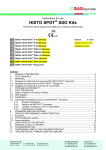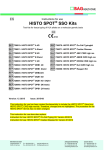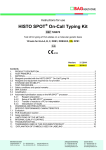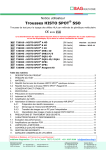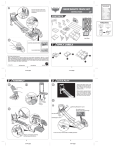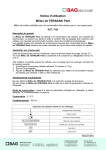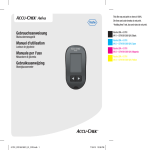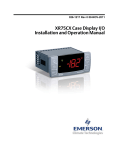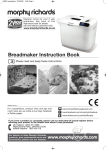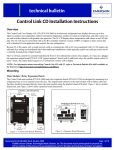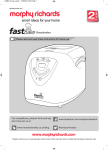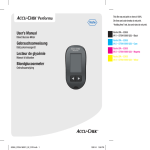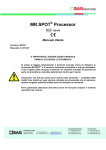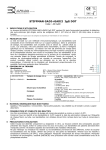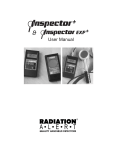Download IFU-HISTOSPOT-CoeliacDisease-V1-2012-EN
Transcript
Instructions for use HISTO SPOT Coeliac Disease Kit Test kits for typing of Coeliac Disease associated HLA alleles on a molecular genetic basis 48 Typings IVD REF 726071: HISTO SPOT Coeliac Disease Version: 1 / 2012 REF 726098: HISTO SPOT Reagent Kit Contents 1. PRODUCT DESCRIPTION .................................................................................................... 2 1.1 Introduction and background ................................................................................................. 2 2. TEST PRINCIPLE.................................................................................................................. 2 3. MATERIAL ............................................................................................................................. 3 3.1 Reagents provided with the HISTO SPOT Coeliac Disease kit ............................................ 3 3.2 Reagents provided with the HISTO SPOT Reagent kit ........................................................ 3 3.3 Reagents and equipment required but not provided .............................................................. 4 4. STORAGE AND STABILITY .................................................................................................. 4 5. TEST PROCEDURE .............................................................................................................. 4 5.1 Safety conditions and special remarks ................................................................................... 4 5.2 DNA isolation ......................................................................................................................... 5 5.3 Amplification .......................................................................................................................... 5 5.4 Automated hybridisation assay on the MR.SPOT processor ................................................ 6 5.4.1 Reagent preparation .................................................................................................. 6 5.4.2 Setup of the MR.SPOT processor ............................................................................ 7 5.4.3 Transfer of results to a PC for interpretation .............................................................. 7 5.4.4 Interpretation of results .............................................................................................. 7 6. WARNINGS AND PRECAUTIONS ........................................................................................ 7 7. SPECIFIC PERFORMANCE CHARACTERISTICS ............................................................... 8 7.1 Evaluation .............................................................................................................................. 8 7.2 PCR Amplification reaction .................................................................................................... 8 7.3 Assay resolution .................................................................................................................... 8 8. LIMITATIONS OF THE METHOD .......................................................................................... 8 9. INTERNAL QUALITY CONTROL .......................................................................................... 8 10. TROUBLESHOOTING ........................................................................................................... 9 11. TRADEMARKS USED IN THIS DOCUMENT/PRODUCT ...................................................... 9 12. EXPLANATION OF SYMBOLS USED ON LABELING ....................................................... 10 BAG Health Care GmbH Amtsgerichtsstraße 1-5 35423 Lich / Germany Tel.: +49 (0) 6404 / 925 - 0 Fax: +49 (0) 6404 / 925 - 250 www.bag-healthcare.com [email protected] Auftragsannahme/Ordering: Tel.: +49 (0) 6404 / 925 - 450 Fax: +49 (0) 6404 / 925 - 460 [email protected] Customer Service: Tel.: +49 (0) 6404 / 925 - 125 Fax: +49 (0) 6404 / 925 - 421 [email protected] Instructions for use HISTO SPOT Coeliac Disease 1. Version: 1 / 2012 PRODUCT DESCRIPTION The HISTO SPOT Coeliac Disease Kit is an in vitro diagnostic test for typing of Coeliac Disease assciated HLA alleles on a molecular genetic basis and provides medium to high resolution typing results. The HISTO SPOT SSO system consists of the HISTO SPOT typing kits, the HISTO SPOT reagent kit, the MR.SPOT processor and the HISTO MATCH interpretation software. The HISTO SPOT typing kits contain all components required for the PCR reaction and testwells with immobilized sequence-specific oligonucleotide probes for the detection of the PCR products. The HISTO SPOT reagent kit contains the reagents for the hybridisation and detection and can be used in combination with all HISTO SPOT typing kits. The MR.SPOT processor is specifically designed to be used with the HISTO SPOT kits in order to process between 1 and 96 samples, automating the process from hybridisation, detection through to result interpretation. The HISTO MATCH software is required to interpret the results. 1.1 Introduction and background Coeliac Disease (CD) is a genetic disorder affecting children and adults (both sexes). It can occur at any age, from infancy (as soon as cereal grains are introduced) to later life (even though the individual has consumed cereal grains regularly). People with CD should not eat food that contains gluten, which is found in wheat, rye, barley and other grains. In people with CD, gluten sets off an autoimmune reaction that causes the destruction of the villi in the small intestine. The people produce antibodies that attack the intestine, causing damage and illness (e.g. tiredness, nutrient deficiency). The onset of the disease seems to require two components: genetic predisposition and some kind of trigger. The trigger may be environmental (as in overexposure to wheat), situational (severe stress), physical (such as a pregnancy or surgery), or pathological (a viral infection). Cause of a clear evidence of a family tendency toward coeliac disease (5-10% of the first-level relatives (parents, children, and siblings) of diagnosed coeliacs may develop coeliac disease), a fast and reliable diagnostic is essential for an early treatment. As mentioned before, CD occurs in genetically predisposed individuals only. The genetic inheritance to coeliac disease is strongly associated with HLA-DQA1*05-DQB1*02 (HLA-DQ2) and HLA-DQA1*03-DQB1*0302 (HLA-DQ8). These alleles serve as docking stations for coeliac disease autoantibodies. More than 90% of persons having coeliac disease carry one of these alleles, either DQ2 or DQ8 (instead of 25% in the general population). So the molecular genetic detection of the HLA-DQ2 and HLA-DQ8 genotypes is a very helpful tool in the coeliac disease diagnostic. When a patient with gastro intestine malfunction has no DQ2 or DQ8 marker, a coeliac disease could be nearly excluded. 2. TEST PRINCIPLE The test includes four basic steps: - DNA isolation - PCR amplification - hybridisation and detection - data interpretation DNA isolation is performed on the clinical sample, using the DNA isolation method established in the laboratory or using commercial kits. Then the DNA is amplified in a locus specific PCR reaction using the mastermix and the MgCl2 solution provided with the kit. The specificity of the amplification is governed by a set of biotinylated primers that have been designed to uniquely amplify the chosen HLA locus. After the PCR amplification process, the PCR plate containing biotin labelled amplicon is transferred to the MR.SPOT processor. MR.SPOT adds hybridisation buffer to each well and then transfers each amplicon plus hybridisation buffer to a test well Page 2 of 10 Instructions for use HISTO SPOT Coeliac Disease Version: 1 / 2012 containing an array of immobilized sequence-specific oligonucleotide (SSO) probes. These probes are either single oligonucleotide probes or a combination of 2 or more individual probes, immobilised in the same spot (Mosaic Probes) which have been designed to improve the identification of cis located polymorphisms. The biotin labelled amplicon binds to those SSO probes that contain a complementary target sequence and can then be detected by a colourimetric reaction. In order to prevent unspecific binding of the amplicon on the surface of the test wells MR.SPOT has blocked the wells with blocking buffer before transferring the amplicon. After a stringent wash step to remove all unbound amplicon a streptavidin-alkaline phoshatase conjugate is added to the wells and binds to the biotin labelled amplicon captured by the SSO probe. After further wash steps, BCIP/NBT substrate is added which produces a blue-purple colour when converted by the alkaline phosphatase. The resulting coloured dots in the bottom of each test well are photographed by MR.SPOT and the image is transferred into the HISTO MATCH software installed on the PC of the user. The image analysis program of the HISTO MATCH software determines the intensity of each spot in the array and compares it to the intensity of the background. From this data the positive and negative reactions are calculated. The pattern matching program of the HISTO MATCH software determines the HLA type of the sample based on the specific hybridisation pattern. 3. MATERIAL 3.1 Reagents provided with the HISTO SPOT Coeliac Disease kit The reagents contained in one kit are sufficient for 48 tests. Each reagent set contains: Testwells l Coeliac Testwells, individually packed, each strip containing 8 tests contains immobilized, sequence-specific oligonucleotide probes 6 strips Mastermix l Coeliac Mastermix, ready to use, contains biotinylated primers, dNTPs,Taq polymerase, reaction buffer, 0.05% sodium azide 650 µl MgCl2 600 µl Magnesium Chloride, 6 mM, ready to use, contains 0.001 % Proclin® 300 With each kit there is a CD containing the batch file that has to be stored within the database of the HISTO MATCH interpretation software (for details see: Instructions for use for HISTO MATCH). For each kit there are lots and batches: Kit: e.g. HISTO SPOT Coeliac Disease, defines the test Lot: e.g CD006, CD007, defines the layout and specificity of the probes that are contained in the kit. A single lot can contain many different batches. Batch: e.g. CD006-1, CD006-2, CD006-3, defines how a probe reacts in comparison to the control probes (cut off values), and defines the manufacture and expiry date of the strips. 3.2 Reagents provided with the HISTO SPOT Reagent kit The reagents contained in one kit are sufficient for 96 tests. Each reagent set contains: BLOCKBUF Blocking Buffer, ready to use, contains 0.001% Proclin® 150 80 ml HYBBUF Hybridisation Buffer, ready to use, contains 0.001% dye, 0.1% sodium dodecyl sulphate, 0.001% Proclin® 150 40 ml STRGWASH Stringent Wash Buffer, ready to use, contains 0.001% dye, 0.1% sodium dodecyl sulphate, 0.001% Proclin® 150 Page 3 of 10 100 ml Instructions for use HISTO SPOT Coeliac Disease Version: 1 / 2012 TBSWASH TBS Wash Buffer (Tris Buffered Saline), ready to use contains 20 mM Tris, 0.003% dyes, 0.001% Proclin® 150 100 ml SUBS BCIP® / NBT Substrate, ready to use (5-bromo-4-chloro-3-indolyl phosphate / nitroblue tetrazolium chloride) 36 ml CONJ Conjugate, Streptavidin Alkaline Phosphatase, concentrate contains < 0.1% sodium azide (to be diluted 1:1666 in Blocking Buffer) 40 µl 3.3 Reagents and equipment required but not provided MR.SPOT processor, including HISTO MATCH software, REF 726100 Pipette tips for the MR.SPOT processor, 1000 µl REF 726099 and 200 µl REF 726097 DNA extraction reagents (no salting out method) Skirted PCR plates with lids or adhesive film (HISTO SPOT PCR plates, REF 726095, HISTO SPOT PCR Caps, REF 726090, HISTO SPOT PCR Foils, REF 726089) Thermal cycler Deionized water Variable pipettes (range 0,5 – 1000 µl) and disposable tips 4. STORAGE AND STABILITY All reagents and components of the kits should be stored at 2…8oC. The expiry date is indicated on the label of each reagent and is valid for the originally sealed reagents. The expiry date indicated on the outer box label refers to the reagent with the shortest stability contained in the kit. Individual strips of 8 wells may be opened, the required number of wells for a test run can be snapped off and the unused wells returned to the opened foil bag and stored for future use with the kit. Test wells stored in open foil pouches should be used within 30 days of being opened. The other opened reagents should be used within 3 months. The conjugate dilution must always be prepared afresh for each test run. 5. TEST PROCEDURE 5.1 Safety conditions and special remarks Molecular genetic techniques are particularly sensitive methods and should be performed by well trained personnel, experienced in molecular genetic techniques and histocompatibility testing. The results from these tests must not be used as the sole determinant for making clinical decisions. Transplantation guidelines as well as EFI standards should be followed in order to minimize the risk of false typings, in the particular case of discrepancies in serological and molecular genetic methods. Special safety conditions must be noted in order to avoid contamination and thus false reactions: Wear gloves during work (powder-free, if possible). Use new tips with each pipeting step (with integrated filter). Use separate working areas for pre-amplification (DNA isolation and preparation of the reactions) and post-amplification (hybridisation and detection). Preferably use two separate rooms. Amplicon should not be taken back into PCR set up area. Use devices and other materials only at the respective places and do not exchange them. Page 4 of 10 Instructions for use HISTO SPOT Coeliac Disease 5.2 Version: 1 / 2012 DNA isolation Prepare sample DNA by the laboratory standard method for DNA isolation for use in PCR (preferably no salting out method). The presence of heparin potentially inhibits PCR. Therefore EDTA or Citrate Blood is recommended for typing. The sample DNA should have a concentration of 15-30 ng/µl and a purity index (extinction ratio OD260/OD280) between 1.5 and 2.0. Higher values indicate the existence of RNA, lower values mean contamination with protein. 5.3 Amplification Use skirted PCR plates for the amplification, because they have to be held down at the skirt by a clamp in the MR.SPOT processor afterwards. HISTO SPOT PCR plates have been validated for this application, plates from other suppliers have to be validated by the user. For each sample to be amplified add the following reagents to each PCR tube: 10 µl Mastermix 5 µl MgCl2 5 µl Sample DNA (15-30 ng/µl) Total volume for each amplification reaction is 20 µl. Premix for multiple samples: no. of samples+2 no. of samples+2 x 10 µl Mastermix x 5 µl MgCl2 use 15µl premix per sample Note: It is important that the DNA concentration is in the range between 15 and 30 ng/µl. Higher concentrations may result in false-positive probe reactions and lower concentrations may cause amplification failures. If a negative control should be done, prepare one PCR reaction with distilled water instead of sample DNA. Seal the amplification tubes with lids or adhesive film and shortly spin down the liquid. Place in the thermal cycler and amplify under the following conditions: Programme-Step Time Temperature No. of Cycles First Denaturation 2 Min 96°C 1 Cycle Denaturation 15 Sec 96°C 10 Cycles Annealing + Extension 60 Sec 65°C Denaturation 10 Sec 96°C Annealing 50 Sec 61°C Extension 30 Sec 72°C ∞ 22°C Hold 20 Cycles The conditions are the same for all thermal cyclers however the overall time required for this step will vary according to the ramping speed of the specific thermal cycler. The following thermal cycler models haven been validated with HISTO SPOT SSO: Applied Biosystems: PE 9600, PE 9700, VeritiTM Biorad: PTC 100 / PTC 200, Mycycler Eppendorf: Mastercycler EP Gradient S If other thermal cyclers are used, the validation has to be done by the user. Once the amplification step is complete, the samples may be tested immediately or stored at 2…8oC for up to 5 days. Page 5 of 10 Instructions for use HISTO SPOT Coeliac Disease 5.4 Version: 1 / 2012 Automated hybridisation assay on the MR.SPOT processor 5.4.1 Reagent preparation Take HISTO SPOT reagents and HISTO SPOT testwells out of the fridge and allow them to warm to room temperature. Salt crystals may be observed in the hybridisation buffer and in the stringent wash solution. If crystals are present, warm reagents up to 30°C to dissolve. Warm the whole content of the bottle, not an aliquot. The conjugate has to be diluted 1:1666 in blocking buffer. The conjugate dilution must always be prepared afresh for each test run. The conjugate has to be vortexed and spun down each time before the dilution step! The required volumes of the reagents will vary depending on the number of strips to be tested. MR.SPOT displays the required volumes for the chosen number of strips. Fill the required volumes of the reagents into the corresponding labelled reservoirs. Place the test wells and the PCR plate into the appropriate blocks of the MR.SPOT processor. Note the correct arrangement of the PCR plate. The teststrips can be separated in single wells according to figure 1, if less than eight tests should be run: Fig. 1: Separating single testwells Separate testwells by snapping them off in a right angle. Break off end pieces with the thumb. Do not break the testwells upwards or downwards and do not twist the wells off . Page 6 of 10 Instructions for use HISTO SPOT Coeliac Disease Version: 1 / 2012 5.4.2 Setup of the MR.SPOT processor Switch on the MR.SPOT processor. The start up screen will appear. Follow the process as indicated on the screen. Details are described in the User Manual for the MR.SPOT processor. 5.4.3 Transfer of results to a PC for interpretation Transfer the data to the HISTO MATCH software via network or USB stick as described in the manual for the HISTO MATCH software. 5.4.4 Interpretation of results Open the HISTO MATCH software (if this is not already installed, it can be installed from the CD delivered with the MR.SPOT processor) and interpret the data as described in the manual for the HISTO MATCH software. 6. WARNINGS AND PRECAUTIONS HISTO SPOT is designed for in vitro diagnostic use and should be used by properly trained, qualified staff. All work should be performed using Good Laboratory Practices. Biological material used for extraction of DNA, e.g. blood or human tissue, should be handled as potentially infectious. When handling biological material appropriate safety precautions are recommended (do not pipet by mouth; wear disposable gloves while handling biological material and performing the test; disinfect hands when finished the test). Biological material should be inactivated before disposal (e.g. in an autoclave). Disposables should be autoclaved or incinerated after use. Spillage of potentially infectious materials should be removed immediately with absorbent paper tissue and the contaminated areas swabbed with a suitable standard disinfectant or 70% alcohol. Material used to clean spills, including gloves, should be inactivated before disposal (e.g. in an autoclave). Blocking Buffer, Hybridisation Buffer, Stringent Wash Buffer and TBS Wash Buffer contain ProClin150 and the Magnesium Chloride Solution contains ProClin300. The reagents contain 0.001% preservative only, nevertheless avoid contact with the skin and mucous membranes. Mastermix and Conjugate contain the preservative sodium azide. The reagents contain < 0.1% sodium azide which is not considered to be a harmful concentration. Nevertheless avoid contact with the skin and mucous membranes. Sodium azide may react with lead and copper plumbing to form explosive metal azides. While disposing of sodium azide containing solutions down laboratory sinks, flush the drains with a large volume of water to prevent azide build-up. All work with reagents should be handled with the appropriate precautions. Wear eye protection, laboratory coats and disposable gloves when handling the reagents. Avoid contact of these materials with the skin, eyes or mucous membranes. If contact does occur, immediately wash with large amounts of water. Burns can occur if left untreated. If spills of reagents occur, dilute with water before wiping dry. Do not expose Substrate to metals, oxidising agents. Disposal of all samples, unused reagents and waste should be in accordance with country, federal, state and local regulations. Avoid microbial contamination of reagents when removing aliquots from reagent bottles. The use of sterile disposable pipettes and pipette tips is recommended. Do not use reagents with evidence of turbidity or microbial contamination. Material Safety Data Sheets (MSDS) are available to download at www.bag-healthcare.com . Page 7 of 10 Instructions for use HISTO SPOT Coeliac Disease 7. SPECIFIC PERFORMANCE CHARACTERISTICS 7.1 Evaluation Version: 1 / 2012 For all HISTO SPOT SSO kits evaluation studies with pre-typed DNA samples has been performed. The results were compared to other typing methods (e.g. SSP, sequencing). No discrepancies were observed between the typing methods. For every lot the specificity of each probe was verified with DNA from reference samples. 7.2 PCR Amplification reaction The alleles amplified with the HISTO SPOT Coeliac Disease kit, the HLA nomenclature release referred to and the exons that are amplified are given in the respective lot specific information. This is found on a CD in each kit. 7.3 Assay resolution The HISTO SPOT Coeliac Disease Kit is designed to provide unambigious results on Coeliac Disease associated HLA alleles. Different combinations of alleles that cross allele groups but have the same positive probe pattern are considered as ambigious. 8. LIMITATIONS OF THE METHOD Because of the high susceptibility of the PCR method to variations in DNA concentration and quality, only DNA samples should be used that have a concentration between 15 and 30 ng/µl and a purity index (extinction ratio OD260/OD280) between 1.5 and 2.0. Extreme care should be taken to prevent contamination of the kit reagents and other laboratory materials and equipment with amplicons or DNA. Regular wipe tests (e.g. BAG Wipetest, REF 7091) and negative controls with each assay are strongly recommended. The hybridisation assay is a very temperature-sensitive process. Therefore, the HISTO SPOT SSO kits should only be used in combination with the MR.SPOT processor to ensure correct temperatures and incubation times. All instruments (e.g. pipettes, thermal cyclers, heat blocks; MR.SPOT processor) must be calibrated according to the manufacturers instructions. Accuracy and temperature uniformity of thermal cyclers may be tested with the BAG CyclerCheck (REF 7104). 9. INTERNAL QUALITY CONTROL Internal quality control of new lots of the HISTO SPOT Coeliac Disease kit can be performed using a combination of DNA samples with known HLA type. Internal positive controls are contained in each test well to ensure sucessful amplification and hybridization. Negative controls to detect possible contaminations are recommended. Use a PCR reaction without DNA in the subsequent hybridization assay as a negative control. Page 8 of 10 Instructions for use HISTO SPOT Coeliac Disease 10. TROUBLESHOOTING Symptom Instrument Malfunction Error message at data transfer No result No Spots in well Only control spots positive False positive probes Exon dropout No result / inconclusive result due to weak signals 11. Version: 1 / 2012 Possible problem(s) Numerous Failure in data transfer Failure to grid image Failure to add mastermix to PCR Failure to add DNA to PCR or amplification failure Too much DNA used or conjugate concentration too high (not spun down). DNA concentration too high or DNA degraded Mistake in conjugate dilution or poor amplification Instrument malfunction TRADEMARKS USED IN THIS DOCUMENT/PRODUCT Proclin® is a trademark of Rohm and Haas company. BCIP® is a trademark of Sigma Aldrich Co. Page 9 of 10 Potential Solution(s) Refer to MR.SPOT manual Manually transfer data using USB drive Perform manual gridding Repeat whole assay and check PCR product on gel Repeat whole assay and check PCR product on gel Check DNA concentarion. Spin down conjugate before use. Check DNA concentration, run a gel with the DNA Repeat assay. Check hybridisation temperature on instrument Instructions for use HISTO SPOT Coeliac Disease 12. Version: 1 / 2012 EXPLANATION OF SYMBOLS USED ON LABELING IVD For in vitro diagnostic use Storage temperature LOT Batch code Use by REF Catalogue number Consult instructions for use HLA TYPING Intended purpose: HLA typing Mastermix | Coeliac Mastermix for amplification of the specific loci Testwells | Coeliac Testwells with bound probes to type the specific alleles MgCl2 Magnesium chloride solution BLOCKBUF Blocking buffer HYBBUF Hybridisation buffer STRGWASH Stringent wash solution TBS Tris buffered saline SUBS Substrate CONJ Streptavidin Alkaline Phosphatase-Conjugate Instructions for use in other languages see: http://www.bag-healthcare.com/en/Diagnostika/Downloads/ Page 10 of 10










